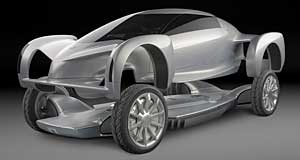Detroit show: GM's fuel cell future
BY BRUCE NEWTON | 9th Jan 2002

Its called the Autonomy and the trick is it's the first car designed around fuel cell technology, rather than being a car designed along traditional lines employing the alternate energy source.
Shown at the Detroit auto show this week, the Autonomy looks like a skateboard because of its slinky, flat chassis, which contains the fuel cell stacks and hydrogen fuel tanks positioned sideways.
In addition, the chassis contains the electronics for "x-by-wire" functions, which allows vehicle systems such as steering and braking to be controlled electronically rather than mechanically. A body can then be attached and essentially plugged in to the chassis.
For Detroit, GM used a sporty body reminiscent of the aircraft-inspired Firebird concepts from the 1950s.
"This is the most significant concept we have ever shown at this or any show," Mr Wagoner, GM president and CEO, told the media at Detroit.
He said the Autonomy concept was the result of GM asking its management, engineers and designers a simple question: "If we were to reinvent the automobile today instead of a century ago, what would we do differently?" GM says the Autonomy concept gives designers freedom to produce various kinds of bodies - from a roadster to a people mover - for a common chassis. Bodies could be changed throughout the lifecycle of the chassis, estimated at 20 years, or the owner could change bodies whenever the mood strikes.
The concept would allow reinvention of the vehicle interior as well. X-by-wire technologies would allow the elimination of pedals, the steering column and the instrument panel. Seating could be more flexible and movable.
Because the chassis operates on fuel cells and hydrogen, it would also provide freedom from petroleum usage and pollution creation since fuel cells produce only water and heat as by products. In addition, the vehicle could produce rather than use energy to be used by cities or a household.
The Autonomy is so named because it provides freedom or autonomy in a number of ways: it runs on hydrogen, thus removing the car from the environmental equation it gives more people in the world the freedom of personal mobility it frees the car owner from the use of petroleum it gives car designers more freedom.
GM is so serious about the concept that it has applied for 24 patents on the chassis and will have a driveable version of the Autonomy by the end of the year.
There are issues preventing Autonomy becoming a production reality, however. Among them are the need for a hydrogen fueling infrastructure and government policies that will encourage investments in fuel cell development.
"If we solve these broader issues, fuel cells will come to market sooner rather than later," Mr Wagoner said. "This is a glimpse of the future."